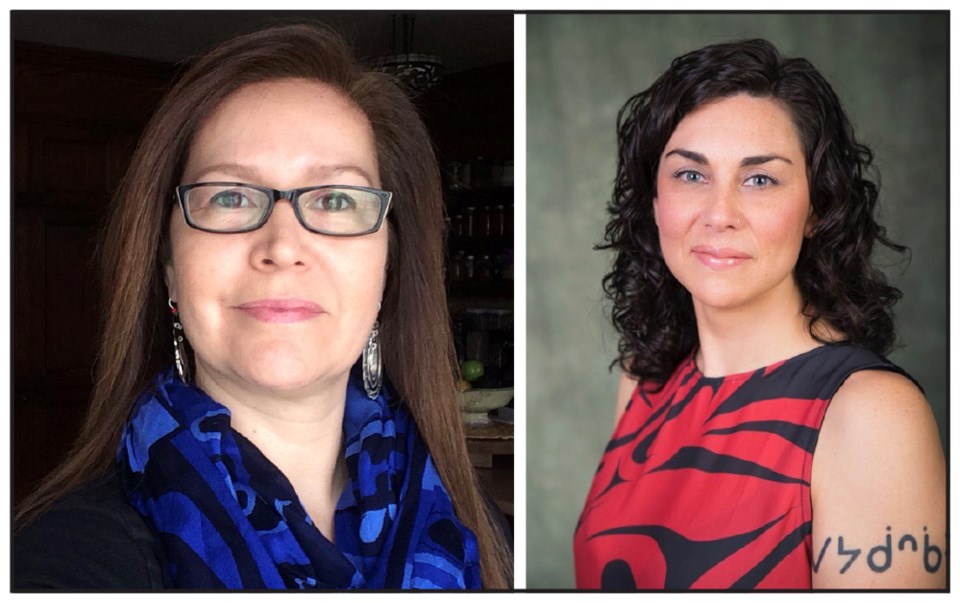Federal funding for NEȾOLṈEW̱, an Indigenous-led language revitalization research project, would not be needed if it weren’t for the devastating impacts of colonialism.
“The heart of the matter is really that our field (of Indigenous linguistics) only exists because of the history of this country, of the intentional historical violent erasure of Indigenous languages,” said Dr. Onowa McIvor, director of the NEȾOLṈEW̱ Research Partnership.
NEȾOLṈEW̱, meaning “one mind, one people” in the SENĆOŦEN language, is currently in year six of seven years of funding from the Social Sciences and Humanities Research Council.
McIvor, maskékow-ininiw (Swampy Cree) and Scottish-Canadian, is a professor in Indigenous education and holds a President’s Research Chair at the University of Victoria.
She was joined by Kahtehrón:ni Iris Stacey in a one hour Zoom presentation May 12 on the first of three days for the Big Thinking lecture series hosted virtually by the Congress of the Humanities and Social Sciences.
Stacey, who is Turtle Clan of the Kanien’kehá:ka Nation from Kahnawà:ke, Mohawk Territory, represents the Kahnawà:ke Education Centre (KEC), one of nine NEȾOLṈEW̱ partners.
While McIvor said it was important to understand the history of the language loss, she also stressed that challenges still existed today.
“It’s also important to remember that this is not only historic. There is an ongoing hostile environment towards Indigenous languages in Canada,” she said. “So acknowledging that ongoing difficulty is also critically important.”
McIvor said it was an “uphill battle” when it came to acknowledging Indigenous languages as the first languages of this country, in creating space and fighting for resources.
“It’s really important for us to pause and acknowledge the truth, even when it makes us uncomfortable, because then we can have a conversation in an honest space because we’re experiencing it. We can’t shy away from it. We experience it every day,” she said.
She added that there could be no reconciliation without first acknowledging the truth.
NEȾOLṈEW̱ is a “radical reclamation of Indigenous languages,” said McIvor, that has been built from the ground up in the nine partnership communities across the country.
The program focuses on adult-language learning. Over the years, it has become apparent that the majority of speakers are becoming elderly, McIvor said.
“We have far too few adult speakers, especially adult speakers who are working age, childbearing age…so there needs to be a specific and special focus on the creation of new adult speakers,” she said.
Stacey said that while in 2022 there are many initiatives and successes to celebrate, the number of language speakers continues to decline.
“The challenges in raising up new speakers are still apparent. So as a community and as the Kanien’kehá:ka Nation we’re stepping up our efforts once again,” said Stacey.
Immersion programs have proven to be the most impactful, she said, and to that end, KEC is focused on supporting their immersion staff who are teaching the language to elementary-aged children.
One in three Elders speak their language, but only one in 10 youth can claim the same.
“It’s not just about elderly speakers, but it’s also those of us who are kind of driving the movement right now that we have a responsibility (to the youth),” said McIvor.
She added that it was important to shift the focus to youth and that it was equally important to have youth guide that focus.
Stacey said language revitalization needed to have the goal of “an intergenerational community of speakers.”
She also pointed out that because of how descriptive Indigenous languages are, they are able to grow and evolve so they can continue to be used and to create vocabulary to represent new concepts or new objects.
McIvor said the focus, at this point, needed to remain with and on Indigenous communities. She said there were still too few Indigenous language speakers and too few resources to branch out into teaching non-Indigenous people.
“I do think that our movement could be strengthened by greater opportunities for non-Indigenous people to learn our languages when appropriate to do so,” she said.
But non-Indigenous people—or allies—still had a role to play in revitalizing Indigenous languages.
“We invite settler allies to take up their responsibility and to have an active role in the continuation and revival of Indigenous languages,” said McIvor, by recognizing that as Canadians, Indigenous languages are also part of their heritage.
The United Nations has declared 2022 to 2032 the Decade of Indigenous Languages.
Organized by the Federation for the Humanities and Social Sciences, Congress 2022 serves as a platform for the unveiling of thousands of research papers and presentations from social sciences and humanities experts worldwide. The goal of the three-day event is to inspire ideas, dialogue and action that create a more diverse, sustainable, democratic and just future. More than 6,000 visitors are expected to log in.



